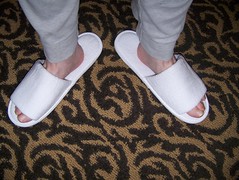I’m hustling to get out of town in three hours for the SOLINET Annual Member Meeting, and I have slides that need updating and tweaking, but I heard something last week I need to nip in the bud.
Linkedin is not a Facebook alternative. Linkedin, for those who do not know, “is an online network of more than 20 million experienced professionals from around the world, representing 150 industries.”
I have an account on Linkedin, and I dutifully update my “network,” approving requests and making sure my profile is up-to-date. But I’m really only on Linkedin just to keep my eye on it.
I am aware that some librarians have proposed that Linkedin is an “alternative” to Facebook. In other words, Linkedin good. Facebook bad. Ok to let librarians and library users on Linkedin. Not ok to let them use Facebook. On the Kubler-Ross social software acceptance scale, for these librarians Linkedin factors in at the “bargaining” stage… they’ll “do” social software, as long as it’s not Facebook (or heaven forbid, MySpace or Livejournal).
(I know libraries that block Facebook. My favorite example is the library that says “no one uses Facebook” and then blocks it anyway. Well, they are correct that their users don’t use it in their library…)
I know professionals who give Linkedin a workout and find it professionally beneficial. But in my book, Linkedin answers the question, “what would Facebook look and feel like if Microsoft had invented it?” It’s chilly, picture-less, and spectral. It feels like some people want work to feel: a disembodied place where Labor is Performed. That’s a soulless way to treat the place we sock away people for 40-80 hours a week.
I realize Facebook has its silly side. After all, I just started a group called “Over Fifty is Facebook-Fabulous.” That’s trivial fun. I also don’t spend a lot of time in Facebook. I ignore actions on Facebook such as sending me “beer,” karma, stuffed beers, or the same dumb video. Once in a while I’ll play a game, but I won’t forward it to my 300+ “friends.” I check in, I tweak my profile, check messages, send a couple out, but I’m not Facebook-obsessed.
But in many ways Facebook feels a lot more like my daily life than Linkedin ever will. On Facebook I can give myself personal context — pictures I like, what I’m doing, my latest blog posts, websites that interest me. I can also see that context. I can share websites and ideas with small and large groups. I can introduce people who can find out much more about the people I’m connecting than Linkedin presents.
I also like that silly stuff happens. It happens at work, doesn’t it? We are a playful species. Adulthood involves knowing when to work and when to play and how to mix the two.
Not everyone I know is on Facebook… but I’ve connected with professionals, family members, and even someone I knew in elementary school. It’s a full environment, not just a slice of Serious Professional Life.
To the librarian who opined that I was unusual for being on Facebook and many of our users aren’t, well, but many of our users are. The fastest growing demographic is users over 25, and I guarantee you that most people I know on Facebook are not high-tech.
I once described two conferences by saying that one had more content but the other was more fun. That wasn’t to dismiss the second; just the opposite, in fact. I would learn more at the second conference. When I am relaxed, happy, and engaged, I’m a sponge for knowledge. Think about your favorite teacher: this person probably had a playful side, or at least radiated joy in his or her subject.
Anyway, to those librarians (and yes, they really exist) who have proposed Linkedin as an “acceptable” alternative to Facebook, ol’ FRL was going to find out sooner or later, and I’m slapping your wrists. Cut it out. Ignore Facebook or jump on board, but I recommend you go directly to the Kubler-Ross “Depression” stage and get it over with.















